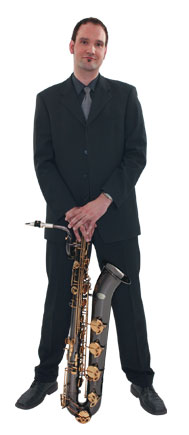Introduction - Swing bigbands
If you have ever played in a bigband with Duke Ellington, Benny Goodman, Count Basie, Buddy Rich, Glenn Miller or are currently a member of a radio bigband, thanks for popping in. But you can go home now.
But for those of who have already tried to play a swing tune with their brass ensemble and found that swing element to be rather elusive despite long and tearful rehearsal sessions, please read on: chances are that you will finally understand what it takes.
Hearing
If you listen to the original melody, you immediately notice a discrepancy between what you see in the score and what you hear: while all quarter notes seem to be in the right places, something odd is happening with the eighth notes.
This ostensible mystery is solved by another indication sometimes found alongside the "Swing" term:
To the right of the tempo indication (63 half notes per minute), you see two eighth notes that are to be considered eighth-note triplets and whose first two parts should be tied to a quarter. This indication thus requests "ternary phrasing" for the piece at hand. "Ternary phrasing" is key to playing swing tunes the way they should sound.
Binary und ternary
The "ternary" notion could be considered the opposite of "binary". These terms refer to the rhythmic distribution of the notes (a.k.a. "phrasing").
"Binary" and "ternary" refer to numbers:
Binary= two (bi)
A quarter note can be divided into two eighth notes of equal length.
Here’s how you need to count: one - and - two - and - three - and - four - and...
Ternary= three (as in tertiary)
In ternary rhythms, quarter notes are divided into eighth note triplets, i.e. three syllables of equal length if one were to count them:
one - a - and - two - a - and - three - a - and - four - a - and...
Feeling the swing
Often, problems regarding swing phrasing are laughed away with remarks like: "That’s something you need to feel..."
Some musicians indeed believe swing to be a "feeling" that cannot be quantified in musical terms. Fair enough, but that doesn’t help us come to grips with swing pieces. Besides, all musical genres only really become music"”and artistically meaningful"”if the "feeling" is right. I’m not saying that the "feel" part is altogether preposterous, though, yet it refers to the triplet-based (ternary) rhythm hidden behind the time signature. This basic feeling needs to become second nature"”you no longer need to think about it, it should come from your guts. And the only way to achieve that is...
Practice, man!
One good exercise would be to set the metronome to ±60BPM and to tap eighth-note triplets on your thighs. Start by alternating between the left and right hand, then complete triplets with your right and left hands, and finally two taps with your right and the third tap with your left hand. Once you have it nailed, you can increase the tempo.
"I don't mean a Thing if it ain't got that Swing"
...ist ein Titel den Duke Ellington Anfang der 1930’er Jahre in Chicago geschrieben hat und wohl das erste Musikstück mit dem konkreten Ausdruck "Swing" im Titel.
Damit auch wir den "Swing" bekommen reicht die Ternäre- oder Swingphrasierung als rhythmisches Element alleine aber nicht aus. Es fehlt uns noch die entsprechende Artikulation.
1. Die Lange Achtel wird immer breit gespielt. Sie hat kein eigenes Ende, sondern hört auf wenn der folgende Ton anfängt.
2. Der Ton nach der Kurzen Achtel wird nicht angestoßen, das heißt, die Kurze Achtel (die + - Achtel) wird weich angestoßen wie z. B. der Buchstabe "D" oder auch das "N" angestoßen würde, der nachfolgende Ton wird gebunden. Auch wenn diese Bindungen nicht notiert sind sollen sie, wenn nicht ausdrücklich anders gefordert, gespielt werden. Der Effekt ist, dass die kurzen Achtel damit so etwas wie eine Auftaktfunktion für den folgenden Ton haben. Für das richtige Swing Verständnis ist hilfreich sich vorzustellen, das die kurze Achtel zum folgenden Ton gehört: + 1 ...
3. Wenn nicht andere Anweisungen dagegen sprechen, werden Viertelnoten mit kurzem Akzent gespielt
Closing remarks
To finish off this workshop, I took the liberty of reposting the initial example. This time, however, it contains all the phrasing and articulation marks discussed in this workshop.
So now the only thing that’s missing is: listen to some bigband swing!
See you soon.
Keep on swinging (like you know you should!)







